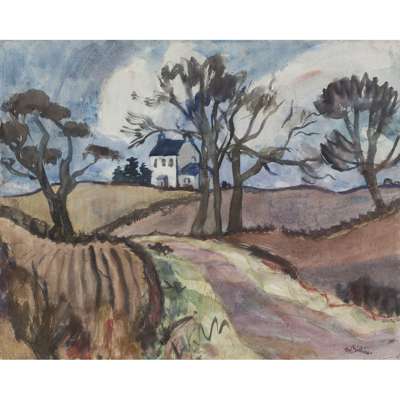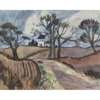
Lot 39

SIR WILLIAM GEORGE GILLIES C.B.E., L.L.D., R.A., R.S.A., P.R.S.W. (SCOTTISH 1898-1973) §
LETHAM FARM


Scottish Paintings & Sculpture
Auction: 9 June 2016 at 19:00 BST
Description
Signed, watercolour
Dimensions
44.5cm x 55.5cm (17.5in x 21.75in)
Footnote
Exhibited: 'Christmas Exhibition, 1972', cat. no. 10, Aitken Dott, Edinburgh
Note:
Gillies was born at Haddington in East Lothian in 1898, the son of a tailor and tobacconist. Largely self-taught in his youth, he gained a place at Edinburgh College of Art in 1916. No sooner had he joined, however than his education was interrupted by military service in WWI. Gillies joined the Scottish Rifles (Cameronians) and served for two years on the Western Front, being both gassed and wounded.
With the end of hostilities, Gillies resumed his studies at Edinburgh and along with some of his fellow students embraced the brave new world of Modernism, looking across the channel to the Post-Impressionism of Van Gogh, the 'wild beasts' Matisse and Derain and the radicalism of Picasso and Braque. His contemporaries at Edinburgh included Sir William MacTaggart and William Crozier and in 1922 with them and six other graduates of the ECA he founded the 1922 group. The following year he travelled on a scholarship to France with another fellow student, William Geissler and studied in Paris under the minor Cubist painter Andre Lhote. Although Gillies later denied Lhote's influence, his early work evinces the effect of the French modernists, in particular of Cezanne and Gris, albeit in a less radical style of the genre.
Back in Scotland Gillies began a teaching career at the ECA, which would last for the next forty years.
His early style soon gave way to a looser touch, although in 1931 Gillies saw the Society of Scottish Artists' influential Munch exhibition in Edinburgh and was deeply affected. He now began to paint in two distinct styles of oil and watercolour, the one being planar and owing much to Bonnard, Matisse and Munch, the latter being loose and expressive, with a feel for the quality of the medium, tempered by sound pencil work.
Gradually, Gillies changed to a more naturalistic style of landscape and still life and became known chiefly for his watercolours, particularly those inspired by the landscapes of rural Midlothian, where he lived for the remainder of his life.
Gillies was a member of the Society of Scottish Artists, the 1922 Group and the Society of Eight. In 1940 he was elected ARSA and RSA in 1947. He became President of the RSW in 1963, was made CBE in 1957 and knighted in 1970.
The pictures included in this sale cover Gillies' career from the late 1940s until the year before his death and offer a good overview of his development.
The latest images here were both exhibited at Aitken Dott's Christmas show in 1972. One, a watercolour of Letham Farm is as simple and spontaneous as Gillies can be, an expression of a spirit of place through pastoral tones, planar recession and confident brushstrokes. The other, an oil of Pittenweem, exhibits Gillie's skill in the medium, harking back to his early French influences and a Matisse-like simplicity but at the same time bringing to both an essentially Scottish palette and character.

